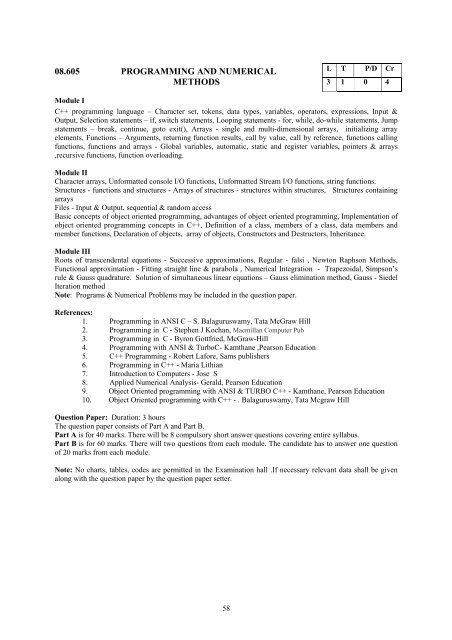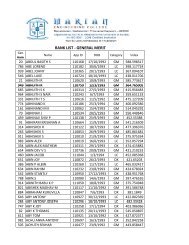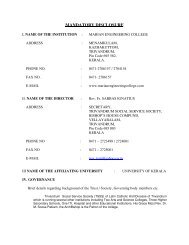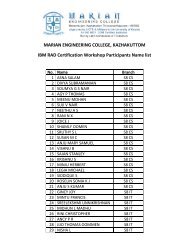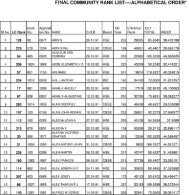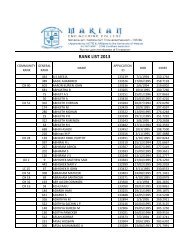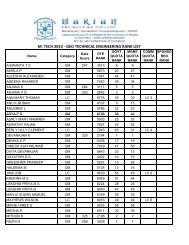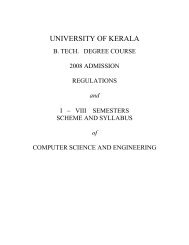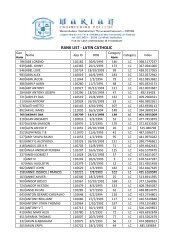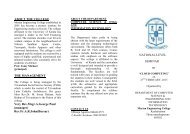UNIVERSITY OF KERALA - College of Engineering, Trivandrum
UNIVERSITY OF KERALA - College of Engineering, Trivandrum
UNIVERSITY OF KERALA - College of Engineering, Trivandrum
Create successful ePaper yourself
Turn your PDF publications into a flip-book with our unique Google optimized e-Paper software.
08.605 PROGRAMMING AND NUMERICAL<br />
METHODS<br />
L T P/D Cr<br />
3 1 0 4<br />
Module I<br />
C++ programming language – Character set, tokens, data types, variables, operators, expressions, Input &<br />
Output, Selection statements – if, switch statements, Looping statements - for, while, do-while statements, Jump<br />
statements – break, continue, goto exit(), Arrays - single and multi-dimensional arrays, initializing array<br />
elements, Functions – Arguments, returning function results, call by value, call by reference, functions calling<br />
functions, functions and arrays - Global variables, automatic, static and register variables, pointers & arrays<br />
,recursive functions, function overloading.<br />
Module II<br />
Character arrays, Unformatted console I/O functions, Unformatted Stream I/O functions, string functions.<br />
Structures - functions and structures - Arrays <strong>of</strong> structures - structures within structures, Structures containing<br />
arrays<br />
Files - Input & Output, sequential & random access<br />
Basic concepts <strong>of</strong> object oriented programming, advantages <strong>of</strong> object oriented programming, Implementation <strong>of</strong><br />
object oriented programming concepts in C++, Definition <strong>of</strong> a class, members <strong>of</strong> a class, data members and<br />
member functions, Declaration <strong>of</strong> objects, array <strong>of</strong> objects, Constructors and Destructors, Inheritance.<br />
Module III<br />
Roots <strong>of</strong> transcendental equations - Successive approximations, Regular - falsi , Newton Raphson Methods,<br />
Functional approximation - Fitting straight line & parabola , Numerical Integration - Trapezoidal, Simpson’s<br />
rule & Gauss quadrature. Solution <strong>of</strong> simultaneous linear equations – Gauss elimination method, Gauss - Siedel<br />
Iteration method<br />
Note: Programs & Numerical Problems may be included in the question paper.<br />
References:<br />
1. Programming in ANSI C – S. Balaguruswamy, Tata McGraw Hill<br />
2. Programming in C - Stephen J Kochan, Macmillan Computer Pub<br />
3. Programming in C - Byron Gottfried, McGraw-Hill<br />
4. Programming with ANSI & TurboC- Kamthane ,Pearson Education<br />
5. C++ Programming - Robert Lafore, Sams publishers<br />
6. Programming in C++ - Maria Lithian<br />
7. Introduction to Computers - Jose S<br />
8. Applied Numerical Analysis- Gerald, Pearson Education<br />
9. Object Oriented programming with ANSI & TURBO C++ - Kamthane, Pearson Education<br />
10. Object Oriented programming with C++ - . Balaguruswamy, Tata Mcgraw Hill<br />
Question Paper: Duration: 3 hours<br />
The question paper consists <strong>of</strong> Part A and Part B.<br />
Part A is for 40 marks. There will be 8 compulsory short answer questions covering entire syllabus.<br />
Part B is for 60 marks. There will two questions from each module. The candidate has to answer one question<br />
<strong>of</strong> 20 marks from each module.<br />
Note: No charts, tables, codes are permitted in the Examination hall .If necessary relevant data shall be given<br />
along with the question paper by the question paper setter.<br />
58


